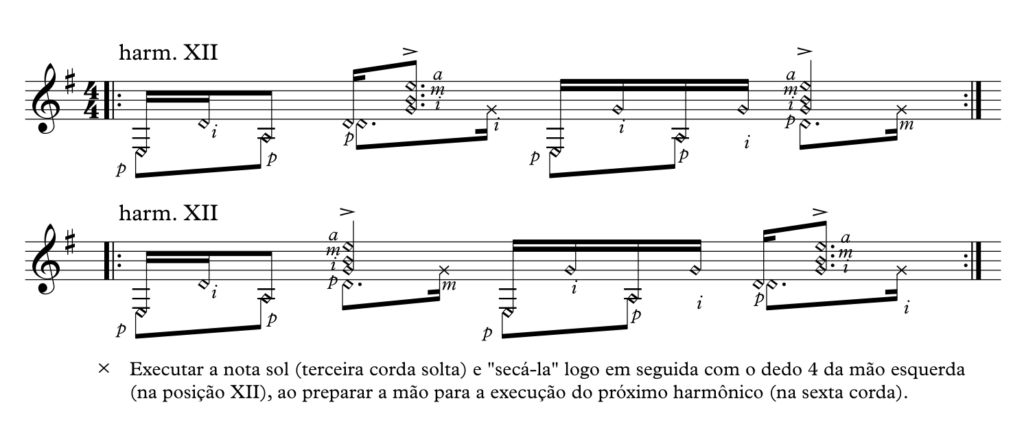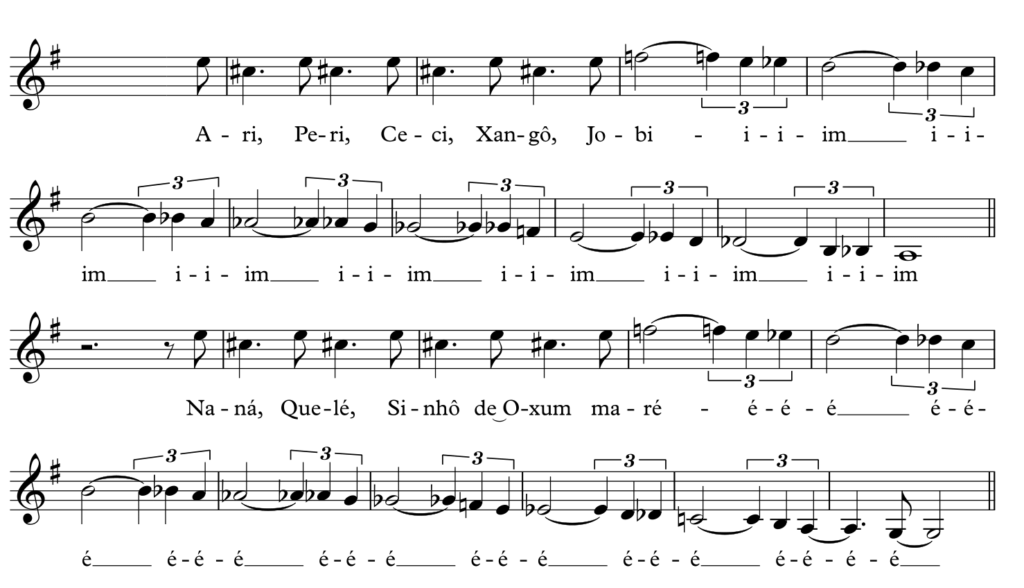5.1 – “Gagabirô” – with João Bosco
JOÃO BOSCO
00:00 an African-Cuban song from very distant time
It is that notion of tribe.
I went to Cuba in 1980 to play
and there I came across an African-Cuban song from very distant time. [i]
That song didn’t come from Cuban dancing music,
like salsa or merengue. [i]
It was inspired in what they call Santeria
which is equivalent to our African religiosity. [i]
01:12 introduction/ prayer in echo
01:58 searching for the quoted source: “old African-Cuban songs”(Egren) [i]
02:21 Gagabirô (João Bosco)
Cuba and its strong black presence show up spontaneously in this dialogue. Cuban composer Léo Brouwer used to say back in the 1970s “all the sonorous apparatus in Cuba is an amplification or transformation of the percussion and the guitar” ” (BROUWER, 1909 apud PRADA, 2008, p. 95). Idea that goes back to African practices that perfectly apply to the manner how the percussive touch of the Brazilian guitar has evolved. [i]

The sophisticated right-hand movement of fingers establishes the song’s structural web and its representation resorts to sheet music signs used for the notation of effects that are typical of the guitar “extended technique”. [i] However, the non-written nature of the material spares its total expression for the “personal manner” that João Bosco “plays”, a result from a unique synthesis that reprocesses a vast amount of information that would hardly sustain itself in the “reading” based on written-tradition-cultivated values. Thus, the general effect of the execution is not effectively transmissible by the sheet music, but only when the listener sees and listens to the execution that, in the last instance, depends on the very performative resources of the author.[i] Just after the execution, the musician highlights melodic-harmonic aspects explored by him:
JOÃO BOSCO
00:00 dodecaphony almost carnival-like.
You’ve got a rhythmic basis in which inclusively dodecaphony fits. Then you make the melody
[sings the initial part]
as if it were a band, almost carnival like,
[sings the same part alluding to the woodwind section]
then you break the tune with a completely atonal melody, out.
[sings the phrase using a descending chromatic contour]

Miles Davis often used this kind of jazz solution.
And then we put one thing together with the other.
01:04 solo show in Switzerland in 1983
02:05 the “G”
02:37 the musician has to know that there are always some others coming to help
03:03 when you don’t know what to do let the music do it.
In the case of the universes approached in this study, it is to highlight that this state and condition of many times “not knowing exactly what to do”, so well illustrated in João Bosco’s statement, is in fact a trace more valued in the “popular” universe – not so rigid in the musical writing – than in the “erudite”, more determined by decisions transported by the score. Not without João Bosco himself complementing it with the idea that, for not knowing when and how the valuable unexpected may appear, the musician has the obligation to constantly improve skills in order to be always technically “ready”. [i] Likewise, the interpreter of formal education in a more defined panorama that is the “erudite” music resorts to intuition – as it is put below by Sérgio Assad commenting a composition of Radamés Gnatalli.
ASSAD
00:00 there are scores that come without any indication [i]
00:20 Radamés and the Brasiliana 8 [i]
00:55 Terry Riley [i]
01:27 to indicate everything may freeze it
-
“thus some music with African features was played in Jamaica, and of course in other places, already modified to meet the new demand of the multi-ethnic community of slaves.” THORNTON, John – A África e os africanos na formação do Mundo Atlântico – 1400-1800. Rio de Janeiro. Elsevier, 2004. pág. 302.
-
LINK with the idea “the erudite interpreters in general pass by this aspect because they have no relation with the Cuban music. They might have never listened to it despite the worldwide fame reached by the salsa”, presented in – 5.2 – a question for Browuer – “ in the statement of Sérgio Assad
-
“in a short definition (…) the African-Brazilian religions are based on trance, animal sacrifice, and direct contact with gods as a way of communing values and establishing sociabilities in relative small communities.” See SILVA, Vagner Gonçalves da – Religion and black cultural identity: Roman Catholics, Afro-Brazilians and Neopentecostalism” – VIBRANT – Revista da Associação Brasileira de Antropologia – ABA, vol. 11, pp 210-246. (Portuguese version: Revista Cadernos de Campo. São Paulo. Departamento de Antropologia da USP, v. 20, n. 20, jan-dez 2011) p. 295.
-
We register here the link for another label that has registered a song also praising Wemba. Herein I express my wish to listen to the LP mentioned by João Bosco: “old African Cuban songs”(Egren). If by any chance anyone has this material – as well as others related to the research, please contact us by the e-mail that is at the opening of the site.
-
LINK with the idea “it is the guitar, which is also a percussive instrument, trying to imitate an instrument that is only percussive” presented in – 5.3 – is it yours? in the statement of Guinga.
-
Gagabirô is mentioned as reference for the study developed by guitarist Daniel Murray, in his Master Degree dissertation entitled Técnicas estendidas para violão: Hibridização e parametrização de maneiras de tocar (Extended Techniques for the guitar: Hybridization and parameterization of ways to play). UNICAMP, 2012 , p. 43.
-
LINK with the idea presented in – 7. Inspiration – in the statement of João Bosco.
-
LINK with the idea “most of the sheet music for the guitar that I have read has very little information. And I even thought that the interpreter had to know it” presented in – 4.5 – playing together in the statement of Sérgio Assad.
LINK with the idea “the music sheet of Guinga’s music pieces do not detail the expressive entities of music ( fermatas, rallentandos or accelerandos)” presented in – 6.5 – something poetic inside music with swing.